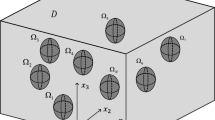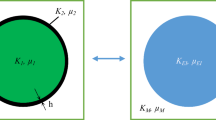Abstract
An embedded cell model is presented to obtain the effective elastic moduli for three-dimensional two-phase composites which is an exact analytic formula without any simplified approximation and can be expressed in an explicit form. For the different cells such as spherical inclusions and cracks surrounded by sphere and oblate ellipsoidal matrix, the effective elastic moduli are evaluated and the results are compared with those from various micromechanics models. These results show that the present model is direct, simple and efficient to deal with three-dimensional two-phase composites.
Similar content being viewed by others
References
Eshelby JD. The determination of the elastic field of an ellipsoidal inclusion and related problems.Proceedings of the Royal Society, London, Series A, 1957, 240: 367–396
Hill R. A self-consistent mechanics of composite materials.J Mech Phys Solids, 1965, 13: 213–222
Budiansky B. On the elastic moduli of some heterogeneous materials.J Mech Phys Solids, 1965, 13: 223–227
Budiansky B, O'Connell RJ. Elastic moduli of a cracked solid.Int J Solids Struct, 1976, 12: 81–95
Christensen RM, Lo KH. Solutions for effective shear properties in three phase sphere and cylinder models.J Mech Phys Solids, 1979, 27: 315–330
Huang Y, Hu KX, Chandra A. A generalized self-consistent mechanics method for microcracked solids.J Mech Phys Solids, 1994, 42(8): 1273–1291
Mclaughlin R. A study of the differential scheme for composite materials.Int J Engng Sci, 1977, 15: 237–244
Hashin Z. The differential scheme and its application to cracked materials.J. Mech Phys. Solids, 1988, 36: 719–734
Mori T and Tanaka K. Average stress in matrix and average elastic energy of materials with misfitting inclusions.Acta Metall, 1973, 21: 571–574
Weng GJ. Some elastic properties of reinforced solids with special reference to isotropic ones containing spherical inclusions.Int J Eng Sci, 1984, 22: 845–856
Benveniste Y. A new approach to the application of Mori-Tanana's theory in composite materials.Mech Mater, 1987, 6: 147–157.
Mura T. Micromechanics of Defect in Solid. Dordrecht: Martinus Nijhoff, 1982
Hashin Z, Shtrikman S. A variational approach to the theory of the elastic behavior of the multiphase materials.J Mech Phys Solids, 1963, 11: 127–140
Dai LH, Huang ZP, Wang R. Explicit expression of bounds for effective moduli by the generalized self-consistent method in multiphase composites. Composites Science and Technology, 1999, 59: 1691–1699
Liang J, Du SY, Han JC. Effective elastic properties of three-dimensional braided composites with matrix microcracks.Acta Material Compositae Sinica, 1997, 14(1): 101–107 (in Chinese)
Zheng QS, Du DX. Closed-Form interacting solutions for overall elastic moduli of composite materials with multi-phase inclusions, hose and microcracks.Key Engineering Materials, 1998, 145–149: 479–488
Wang ZQ, Duan ZP. Plastic Micromechanics. Beijing: Science Press, 1995 (in Chinese)
Tanaka K, Mori T. Note on volume integrals of the elastic field around an ellipsoidal inclusions.J Elasticity, 1972, 2: 199–200
Zhao YH, Tandon GP, Weng GJ. Elastic moduli for a class of porous materials.Acta Mechanica, 1989, 76: 105–131
Sayers CM, Kachanov M. A simple technique for finding effective elastic constants of cracked solids for arbitrary crack orientation statistics.Int J Solids Structures, 1991, 27: 671–680
Author information
Authors and Affiliations
Additional information
The project supported by the National Natural Science Foundation of China (No. 19704100) and the National Natural Science Foundation of Chinese Academy of Sciences (No. KJ951-1-201)
Rights and permissions
About this article
Cite this article
Shige, Z., Tzuchiang, W. Effective elastic moduli of inhomogeneous solids by embedded cell model. Acta Mech Sinica 15, 334–343 (1999). https://doi.org/10.1007/BF02487931
Received:
Revised:
Issue Date:
DOI: https://doi.org/10.1007/BF02487931




